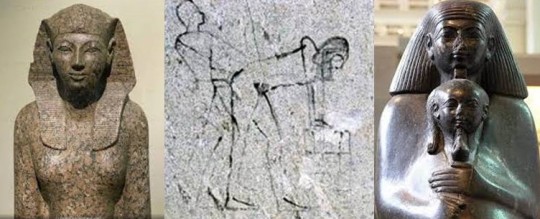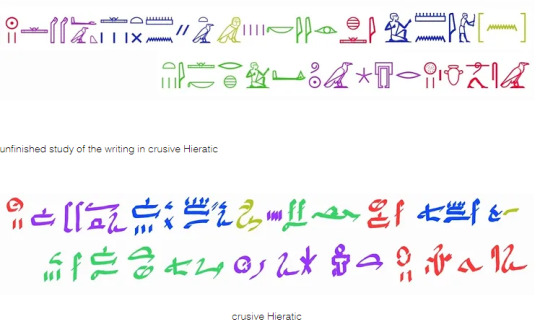#senenmut
Explore tagged Tumblr posts
Text

Statue of Senenmut holding Neferure, daughter of Hatshepsut
Most of us are familiar with the block and seated (tutor) statues of Senenmut and Neferure. This standing statue of Senenmut holding Princess Neferure, daughter of Queen Hatshepsut, seems to be unique.
The statue was found in Karnak and was a gift from the Queen. The inscriptions are given in detail in breasted ancient records and some of the details are quite interesting. Senenmut lists his duties as Architect and it becomes clear from the inscription that his work was spread over a sizable area.
New Kingdom, mid 18th Dynasty, reign of Hatshepsut, ca. 1479-1458 BC. Made of black granite. Now in the Field Museum, Chicago. 173800 Read more
126 notes
·
View notes
Text
I prefer Hakuryuu Ren's character arc in Magi: The Labyrinth of Magic, Scar's in Fullmetal Alchemist, and Sitre's, Senenmut's, and Neferure's in Aoi Horus no Hitomi to Custas' in Witch Hat Atelier.
Unlike Custas who suddenly turned so unreasonably hostile to Coco and Tartah the moment he met Ininia, Scar didn't suddenly turn to the good side just because he met May Chang.
#Magi: The Labyrinth of Magic#Shinobu Ohtaka#Hakuryuu Ren#Fullmetal Alchemist#Hiromu Arakawa#Scar#May Chang#Aoi Horus no Hitomi#Sitre In#Senenmut#Neferure#Witch Hat Atelier#Tongari Boushi no Atelier#Kamome Shirahama#Custas#Ininia#Coco Witch Hat Atelier#Coco WHA#Tartah
6 notes
·
View notes
Text
HATSHEPSUT & SENENMUT
HATSHEPSUT AND SENENMUT
Hatshepsut became regent to her young stepson after her husband died. As her stepson became a teenager he was more interested in riding in chariots, hanging out with people his own age, hunting and going into battle. He had no interest at the time for politics or to hang out with older people. Hatshepsut died in 1458 BCE, and then her stepson came to power.
Senenmut was a powerful figure during Hatshepsut’s rule. He was a commoner but was educated, intelligent and talented, Hatshepsut relied on him for building projects and he also became her daughters tutor; there are monuments depicting Senenmut and the princess together. Due to his intellect and talents he grew high in the royal court. Senenmut was the architect of Deir el-Bahri and also put an image of himself and his name on the walls, which is unusual for a commoner. He also was documented as saying, “I entered the mysteries of the lady of the two lands”.
Hatshepsut never remarried, and Senenmut never got married or have children, which was unusual for a man in Ancient Egypt. If the two were lovers they would have had to keep it a secret, as it wouldn’t have been permitted for royalty to be with a commoner. During her rule, one of Senenmut’s workers who was working in the DjeserDjeseru tomb, graffitied on the wall and drew an image of Senenmut having sex with a female pharaoh (Hatshepsut).
Senenmut had two tombs built, one for Hatshepsut and one for himself, they were built in the same proximity to each other. When Senenmut died, she gave her own sarcophagus for him to be buried in, no commoner has ever had the privilege to be buried in a royal sarcophagus before. Hatshepsut died a few years after.
Their tombs were vandalized when Hatshepsut’s stepson and his own son reigned, as they wanted Hatshepsut’s memory to be erased.

#hatshepsut #senenmut #ancientegypt
1 note
·
View note
Text

Shebiu Necklace of Amenhotep - Met Museum Collection
Inventory Number: 36.3.154 New Kingdom, Dynasty 18, ca. 1479–1458 B.C. Location Information: From Egypt, Upper Egypt, Thebes, Sheikh Abd el-Qurna, below the Tomb of Senenmut (TT 71), Burial of Amenhotep, on coffin lid, MMA excavations, 1935–36
Description:
This necklace of lentil-shaped beads was found on top of the coffin of a twelve-year-old boy named Amenhotep (36.3.153). The necklace and two armlets found in Amenhotep's coffin (36.3.155, 36.3.156) are made of Egyptian faience, a ceramic material made of quartz frit. These pieces of jewelry are sized for an adult, and may have been a gift from the child's father.
Gold necklaces of lentoid beads (shebiu-collars) and arm bands (a'a-armlets) were part of the honor jewelry presented by the king to important officials other highly valued individuals. Combinations of gold and blue armlets are depicted in tomb paintings (see the detail of facsimile 30.4 106 above), and it is possible that the faience versions of the gold jewelry were part of the sets, not just imitations.
#Shebiu Necklace of Amenhotep#upper egypt#thebes#sheikh abd el qurna#sheikh abd el-qurna#tomb of senenmut#new kingdom#new kingdom pr#dynasty 18#met museum#36.3.154#necklace#necklaces#jewelry#NKPRJ
2 notes
·
View notes
Text
you ever talk through your research while pretending blorbo from your media is listening and then have a major scientific revelation that could change the context of your research itself? yeah me too. anyways
#mine#personal#ill figure out a tag for this research so i dont just keep calling it My Research and that way the tag can be muted if u dont care about it#maybe like#sentomb#yeah that works#if u dont care then block ‘sentomb’#anyways. so was senenmut dying or was hatshepsut dying. who was dying because it was sure someone
0 notes
Text

Foundation Stone with Inscriptions
Egyptian, 1479-1458 BCE (New Kingdom)
Daughter of King Thutmose I and wife of her half-brother, King Thutmose II, Queen Hatshepsut eventually ruled Egypt as pharaoh in her own right. This commemorative stone was placed at a construction site, probably of the temple built for her at Deir el-Bahari, one of the most beautiful monuments of ancient Egypt. It bears the queen's throne name, Maat-ka-re, as well as that of the temple's architect, Senenmut.
105 notes
·
View notes
Text

Statues of Hatshepsut
Metropolitan Museum of Art, Egyptian Art Collection
On view at The Met Fifth Avenue in Gallery 115
Period: New Kingdom
Dynasty: Dynasty 18
Reign: Joint reign of Hatshepsut and Thutmose III
Date: ca. 1479–1458 B.C.
Geography: From Egypt, Upper Egypt, Thebes, Deir el-Bahri, Senenmut Quarry, MMA excavations, 1927–28
Medium: Granite
Dimensions: H. 261.5 cm (102 15/16 in.); W. 80 cm (31 1/2 in.); D. 137 cm (53 15/16 in.)
Accession Number: 29.3.1, 30.3.1
4 notes
·
View notes
Text

Artist's Gridded Sketch of Senenmut, an important official of Hatshepsut
From Egypt, New Kingdom, ca. 1479–1458 B.C.
In the Met Museum
4 notes
·
View notes
Text

'' [A] Nakht-Amoun. Do four of these, exactly. Hurry for the day after tomorrow. These are your instructions (lit. I cause you to know them).''
#ancient egypt#architecture#egyptian#egyptian gods#egyptology#kemetism#kemeticism#egyptian architecture#sekhmet#architetteeeeura#egyptian archaeology
7 notes
·
View notes
Text
Quizás la más grande reina del antiguo Egipto aparte de Cleopatra VII fue Hatshepsut, que reinó del 1473 a. C. al 1458 a. C., aunque no fue la primera mujer que asumió el poder como monarca en solitario de las Dos Tierras. Pero Hatshepsut sin duda se labró su propia fama, a pesar de los intentos de su sobrino e hijastro Tutmosis III por borrarla de la historia, y también la de sus seres queridos, entre ellos el jefe de su gobierno (y su posible amante), Senenmut.
2 notes
·
View notes
Text

Statue of Senenmut holding Neferure, daughter of Hatshepsut
Most of us are familiar with the block and seated (tutor) statues of Senenmut and Neferure. This standing statue of Senenmut holding Princess Neferure, daughter of Queen Hatshepsut, seems to be unique.
The statue was found in Karnak and was a gift from the Queen. The inscriptions are given in detail in breasted ancient records and some of the details are quite interesting. Senenmut lists his duties as Architect and it becomes clear from the inscription that his work was spread over a sizable area.
New Kingdom, mid 18th Dynasty, ca. 1479-1458 BC. Now in the Field Museum, Chicago. 173800
Read more
57 notes
·
View notes
Note
What is your level of interest in architecture? Who are some of your favorite architects?
I know so little about architecture tbh I like Tony Smith’s work as an architect and some other artists who have some background in architecture and then people like Ricardo Bofill, Bertrand Goldberg, Luis Barragán but I know very little about architecture and the surrounding philosophy and basically just go off of vibes… I think Hatshepsut’s architect Senenmut was one of the greatest ancient architects? I would love to learn more as always but never felt particularly compelled
4 notes
·
View notes
Text

Relief Fragment Depicting a Kneeling Woman - Met Museum Collection
Inventory Number: 36.3.239 New Kingdom, Dynasty 18, ca. 1479–1458 B.C. Location Information: From Egypt, Upper Egypt, Thebes, Sheikh Abd el-Qurna, Tomb of Senenmut (TT 71), statue niche, MMA excavations, 1935–36
Description:
This fragment of relief was part of the decoration of a statue niche in the offering chapel of Senenmut (TT 71). The hieroglyphs above the kneeling woman probably identify her as "his (Senenmut's) beloved sister Ahmose." This reconstruction of the partly missing text is reinforced by the inscription o a wooden Osiris figure dedicated to a woman named Ahmose (36.3.231) that was discovered in the debris below the chapel.
#Relief Fragment Depicting a Kneeling Woman#new kingdom#new kingdom pr#dynasty 18#upper egypt#thebes#Sheikh Abd el-Qurna#Sheikh Abd el Qurna#Tomb of Senenmut#met museum#36.3.239#womens hair and wigs#NKPRWHW
2 notes
·
View notes
Text
#BlogTour ~ Lovers in Hell by Janet Morris @perseid_press @SDBookTours
Only fools fall in love, and hell is filled with fools. Lovers in Hell A Heroes in Hell Anthology by Janet Morris Genre: Dark Fantasy Anthology Only fools fall in love, and hell is filled with fools. Our damned lovers include: Christopher Marlowe and Will Shakespeare, Napoleon and Wellington, Orpheus and Eurydice, Hatshepsut and Senenmut, Abelard and Heloise, Helen and Penelope, Saint Teresa…

View On WordPress
0 notes
Text
Lovers in Hell Book Tour & Giveaway - 2/15 to 2/29
Only fools fall in love, and hell is filled with fools. Lovers in Hell A Heroes in Hell Anthology by Janet Morris Genre: Dark Fantasy Anthology Only fools fall in love, and hell is filled with fools. Our damned lovers include: Christopher Marlowe and Will Shakespeare, Napoleon and Wellington, Orpheus and Eurydice, Hatshepsut and Senenmut, Abelard and Heloise, Helen and Penelope, Saint…

View On WordPress
0 notes
Text

Hathor-Head Frieze in the Tomb of Senenmut. Period New Kingdom ~ ca.1479–1458 B.C. Upper Egypt, Thebes. Met Museum
0 notes